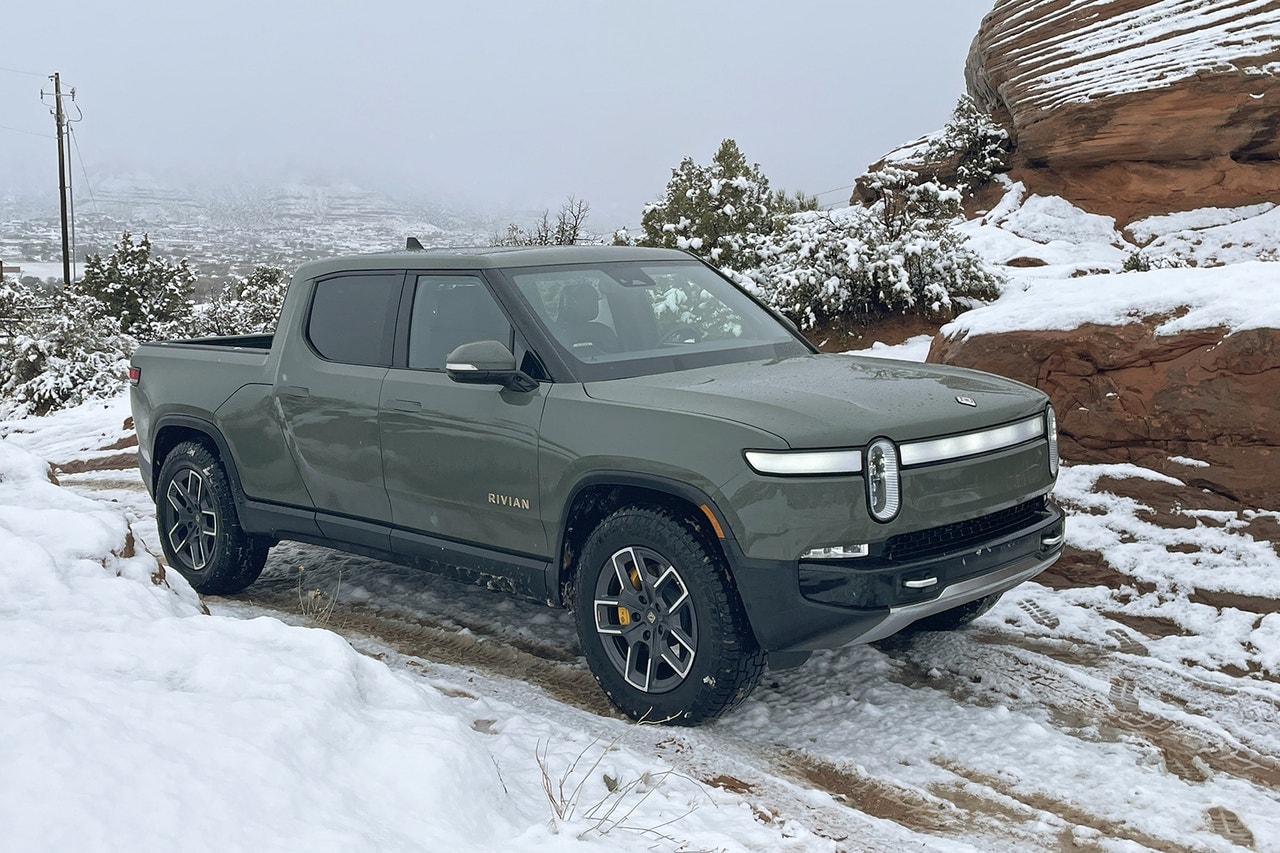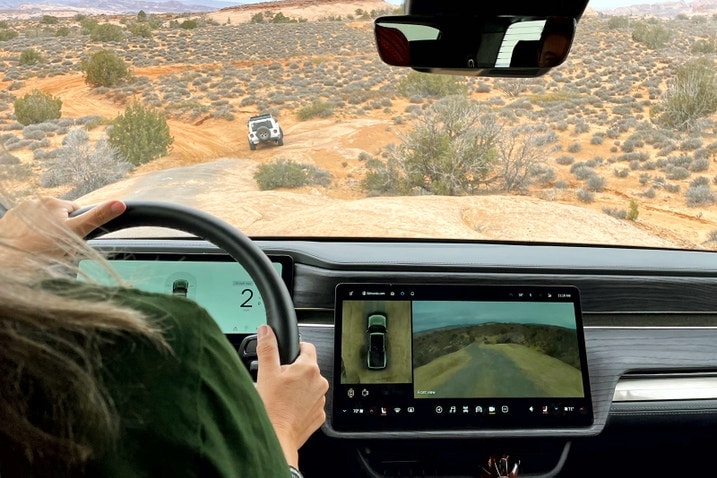- We take our long-term Rivian R1T on a road trip through the Rockies in winter.
- The electric truck's off-road capabilities are impressive.
- However, the climate control system struggles to keep up in below-freezing temps.
How Our Long-Term Rivian R1T Fares in Seriously Cold Weather
A winter road trip meant subzero temperatures and required a little extra time
When I asked Mike Schmidt — gatekeeper of Edmunds' long-term fleet — if there were any vehicles available for an upcoming holiday road trip and he suggested the all-electric Rivian R1T, I’ll admit I was apprehensive. I’ve had plenty of time in EVs, but always in fair-weather situations. Now I’m supposed to drive this rolling electron-eating computer up and over the Rocky Mountains — in winter? With my mother? Why am I doing this to myself?
Here's how we fared on our trip, which took us from the high desert of California through Las Vegas to Interstate 70 and over the Rocky mountains to Boulder, Colorado.
Pushing the public electrons
I finally got a chance to experience the Rivian’s navigation system and it’s pretty good in some ways, pretty dismal in others. Input a destination and it will give a recommended charging stop including a fairly accurate prediction of how many miles will be left in the battery when you get there.
I like the satellite view on the nav (provided by Mapbox) and that I can filter my public charging stops by speed, network and availability. However, you might want to double-check the actual location of said public chargers. The system directed me to an Electrify America station in Grand Junction, Colorado, but it was an eight-minute drive off the highway. When you’re already spending 20-30 minutes to nab a charge up to 85%, a 16-minute round trip drive to and from the highway is the last thing you want. You should also check the reviews of the recommended station on PlugShare, as real-world conditions can change quickly.
You should also remember that our public charging infrastructure is experiencing some major growing pains. My quickest stop was 30 minutes from freeway exit to freeway entrance, but I was held up in Cedar City, Utah, for much longer. The charging station was packed, not all chargers functioned properly, and I had to wait for a Lucid Air to finish charging to 100%.
It’s best to end public charging at an 80% or 85% state of charge, both for the health of your battery and to give fellow drivers a chance to fill up, so the Lucid was really in bad form here. It pushed my total time from freeway exit to entrance time up to 90 minutes.
Navigation niceties
The navigation system wasn’t so great at predicting traffic congestion. More than once I’d be dead stopped in holiday traffic but the nav was showing an open road. Rivian says Mapbox supplies its traffic data, and while I love the great satellite imagery I can get, I always looked to Google Maps to get an idea of how crowded the roads were.
Rivian does not offer Apple CarPlay or Android Auto smartphone integration, a terrible move in my opinion. Not only can I get Google maps to check traffic conditions with this technology, but off-road apps like Gaia and onX can be streamed on Apple CarPlay, offering a more robust navigation experience when off-road than the native nav system. I would have welcomed using either one when I took the truck into the red rocks of Moab.
Rockin' in the Rivian
I couldn’t let America’s premier rock-crawling destination pass me by, so I detoured off I-70 to Moab, Utah. While the R1T’s 135.8-inch wheelbase is pretty long for rock crawling — a Wrangler Unlimited comes in at just 118.4 inches — the air suspension does a great job of mitigating the situation. When pushed up to its max ride height of nearly 15 inches, the breakover angle is a stellar 26.4 degrees. That’s only 0.3 degree less than the aforementioned Jeep's breakover angle when equipped with the optional 35-inch tires. It’s actually more when the Wrangler sits on the standard 33s.
What this means is that the Rivian won’t scrape along the bottom or get high centered when the road turns rocky.
However, the approach and departure angles don’t come close to matching a Wrangler's, so I still had to pick careful lines over the rocks. The off-road navigation system onX rates one of my favorite trails, Fins and Things, at a Level 4 difficulty, but the Rivian never scraped its front or rear. On the few places where the Off-Road Auto setting couldn’t make the climb on the steep slickrock, I switched the driving mode to Rock Crawl. This mode allows for the maximum amount of torque to be fed through the four motors and out to the wheels, and torque can be shifted to any wheel the system wants almost instantly. The result is that the R1T in Rock Crawl climbed right up anything I threw at it and begged for more.
I would tell you the slope of the faces I climbed in the Rivian, but the truck doesn’t give any off-road information. There isn’t any page that gives pitch and roll data, steering angle and the like. I want to brag about how great the truck is off-road, but it doesn’t give me the data to shout to the world.
Less than zero
The last four hours of our trip the Rivian struggled to keep the cabin warm when temperatures dipped into the negatives. Without an engine radiator to push heat into a heat exchanger and then into the cabin, the HVAC system really has to work to keep the chill at bay, especially when the weather plunges to minus 17. The heated seats work great, as does the heated steering wheel, but even with the system cranked up to 80 degrees, the cabin was less than ideal for two California folks.
One evening I parked the truck with 37% state of charge. A night of subzero temps took it down to 28%. Once the Arctic air left Colorado and overnight temperatures were into the 30s, the truck lost a more reasonable 4% state of charge overnight. This isn’t exclusive to the Rivian. Battery chemistry takes a poop in the cold. Science, y’all.
And a drumroll for efficiency ...
For the trip I kept the speed at or just above the speed limit and in all we averaged roughly 1.955 miles per kilowatt-hour driving mostly in Conserve mode over 2,500 miles. That works out to an average consumption of 51.1 kWh/100 miles, or slightly more efficient than Edmunds' overall consumption of 51.6 kWh/100 miles. Our average cost was $0.44 per kWh.
Edmunds says
My road-trip experience in an EV wasn’t much different than I’ve had in a gas- or diesel-powered vehicle save for the extra time required to charge. The R1T’s HVAC system might give those living in extreme cold climes pause, but it performed adequately when the mercury was above zero degrees. Of course, some folks may not have the patience for public charging and that’s understandable, but don’t let the fear of the unknown stop you from diving into the EV world. It’s going to be just fine.











.jpg) by
by